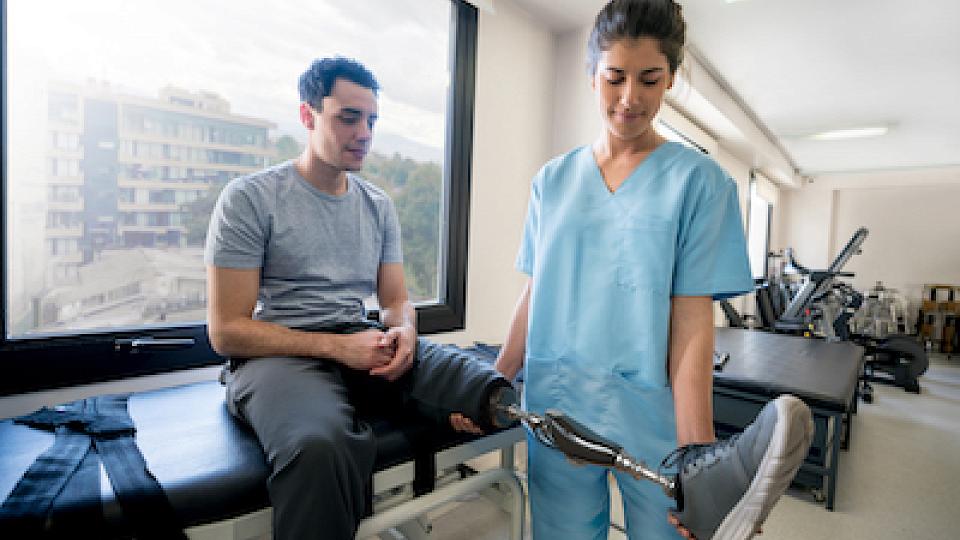
Diagnosing and Treating Pain After Amputation Surgery

Diagnosing and Treating Pain After Amputation Surgery
After an amputation, some patients may feel pain in their residual limbs. Post-amputation pain, categorized as phantom pain or stump pain, can be a challenging condition to treat.
Phantom pain is different from stump pain, but they often occur together. Describing your post-amputation pain can help your doctor accurately diagnose and treat these two conditions.
Phantom Limb Pain
Phantom limb pain feels like it's coming from a body part that's no longer there. Doctors once believed this post-amputation phenomenon was a psychological problem, but experts now recognize that this is a real sensation originating in the spinal cord and brain.
"Many layers are involved in determining the causes of phantom limb pain," says Colby Hansen, MD, an associate professor in the Department of Physical Medicine and Rehabilitation at University of Utah Health. "A combination of both central (brain and spinal cord) and peripheral (nerves in the affected extremity) nervous system can contribute to phantom limb pain."
Symptoms
Characteristics of phantom limb pain can start within the first week, be delayed months after amputation, can come and go, or be continuous. Amputees describe phantom limb pain as shooting, stabbing, cramping, crushing, throbbing, or burning. For many, it may resemble the type of pain they may have experienced in their limb before amputation.
Diagnosis
Although there's no medical test to diagnose phantom pain, doctors identify the condition based on your symptoms and the knowledge that phantom pain could be caused by a miscommunication between your brain, spinal cord, and nerves that continues after your amputation. Your physician will ask you about other causes that can worsen your pain, including stress, anxiety, depression, and pain in the limb before amputation.
Treatment
For some people, phantom pain gets better over time without treatment. For others, managing phantom pain can be challenging. Hansen says a team effort by health care professionals including physical therapists, psychologists, surgeons, and prosthetists results in alleviating phantom pain effectively through:
- Over-the-counter pain relievers and some stronger medications
- Antidepressants
- Physical and occupational therapy
- Injections
- Surgery on the residual limb and nerve
- Electrical stimulation
- Wearing a prosthetic more frequently
- Mirror therapy
- Standard relaxation techniques such as mindfulness, guided imagery, gentle massage, and listening to music
Stump Pain
Stump pain, also called residual limb pain, is a type of pain felt in the part of a limb that remains after an amputation. It occurs in about half of people within the first week following an amputation but also may last beyond healing.
Symptoms
Residual limb pain varies in severity, but you may feel uncomfortable sensations such as pressing, throbbing, burning, squeezing, or stabbing.
Diagnosis
Tests and procedures used to diagnose stump pain include:
- Physical exam: Checks for skin breakdown, pressure sores, bone problems, signs of infection, and masses. Your doctor may detect a neuroma—a tangle of nerve endings that can form after amputation—and complications with the fit or use of a prosthesis.
- Imaging tests: MRI, CT scan, X-rays, or ultrasound help rule out other causes for your pain and identify fractures, bone abnormalities, tumors, and infection.
- Blood tests: Detect other medical conditions that could result in pain.
Treatment
Treatment for stump pain focuses on treating the underlying cause of the pain. Stump pain eventually improves without treatment in about half of the patients. Pain relief options include medications (pain relievers, antidepressants, and anticonvulsants), physical and occupational therapy, massage, hypnosis, nerve blocks, and neuromodulation.
At University of Utah, Hansen and other physicians use the most advanced techniques to restore strength, function, control, and avoid pain. One such approach is targeted muscle reinnervation (TMR) surgery to split the ends of the nerves and place them into muscles where they will grow into new muscles. TMR surgery can prevent pain and allow prosthetic limbs to read signals from the muscles.
An amputee whom Hansen cared for did not have residual pain for about eight years following a leg amputation due to a traumatic injury. However, during a clinic visit, the amputee reported burning and tingling pain that may have been caused by a neuroma forming off his sciatic nerve. He was treated for delayed stump pain using therapies of medicine, injections, and ultrasonography-guided radiofrequency ablation to relieve post-amputation pain. Hansen found that a combination of strategies such as these has worked to relieve the amputee’s occasional residual pain when it reoccurs.
"The sorting out of the causes of pain can be tricky, but with the patient’s and health care providers’ perseverance, many amputees can be pain-free through psychological and therapeutic strategies," Hansen says.
Craig H. Neilsen Rehabilitation Hospital
Our hospital was built for patients—of all capabilities—to interact with their surroundings in real-time. Our smart technology enables patients greater control of the space around them and their recovery. Come experience it for yourself.

Mirror Therapy to Treat Phantom Limb Pain
After an amputation, sensations or pain where the removed limb once was can significantly interfere with a person's quality of life. Colby Hansen, MD, and Spencer Thompson, DPT, discuss how consistent therapy with a simple mirror can help to alleviate the condition.





